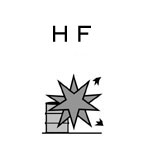| Case Name |
Explosion of hydrogen during cleaning a water scrubber at a semiconductor plant |
| Pictograph |

|
| Date |
December 19, 1996 |
| Place |
Hiji, Oita, Japan |
| Location |
Semiconductor factory |
| Overview |
An explosion occurred during cleaning of exhaust gas-processing equipment at a semiconductor factory. The inside of the water scrubber was washed with hydrogen fluoride acid. Hydrogen was generated by a reaction of an adhering silicon compound with hydrogen fluoride acid. As air flowed backwards at the drainage of cleaning fluid, a combustible gas-air mixture was formed. As a compound that reacts with water and is decomposed explosively was generated in the scrubber, the mixture ignited and exploded. Generation of hydrogen was not grasped in advance. The operator changed the work procedure at his own judgment. |
| Incident |
At a semiconductor factory, a water scrubber of exhaust gas processing equipment for special gas was washed once a month. At that time, hydrogen was generated and air that flowed backwards mixed and exploded. The water scrubber was damaged by the explosion. Moreover, two persons were exposed to the solution which was scattered and were slightly injured. Generation of hydrogen was not recognized. |
| Processing |
Consumption and usage |
| Substance |
Hydrofluoric acid, Fig2 |
| Hydrogen, Fig3 |
| Type of Accident |
Explosion |
| Sequence |
17:30 on December 18th, 1996. Exhaust gas processing equipment was stopped. The valve of piping to the water scrubber was shut, and purging of gas in the piping and exhaust gas-processing equipment with nitrogen began.
09:45 on February 19th. Hydrogen fluoride acid was poured into the bottom section after draining water at the scrubber bottom. Next, nitrogen was poured, hydrogen fluoride acid was supplied to the scrubber, and the scrubber pump started to wash silicon dioxide attached to the wall.
As the washing nozzle was clogged with dirt, nitrogen was stopped and hydrogen fluoride acid was added.
11:04.The water level was controlled by automatic operation, hydrogen fluoride acid was diluted by the water supplied, and overflow during circulation was drained.
11:10. The valve for nitrogen was opened a little and nitrogen was added. An explosion occurred. The water scrubber ruptured. |
| Cause |
Material adhering to the internal surface was silicon covered with silicone oxide. After the surface silicone oxide dissolves, silicon and hydrogen fluoride react, and hydrogen is generated. The above became clear after the accident.
When the level of hydrogen fluoride acid was lowered, air flowed backwards from exhaust gas-processing equipment, and a combustible gas-air mixture was generated.
The ignition source was assumed to be as follows. A compound such as cyclo di-sill thiane in which sulfur, silicon, and fluoride are combined reacted with water, and decomposed explosively. |
| Response |
The injured were rescued. |
| Countermeasures |
Changing the structure to prevent a reverse flow of air.
Installing a flow meter and conducting enough purging with nitrogen.
Not allowing operators to change operation standards by their own judgment.
Wearing protective gear. |
| Knowledge Comment |
A special hazardous material must be handled more carefully than a common hazardous material.
Even in a washing or waste process, the fundamental danger of highly hazardous material does not change.
Toxic and corrosive hazardous materials are handled using a closed system for safety. However, it is desirable to use a scattering prevention device and a protector because the hazardous material might spread in an accident. |
| Background |
The management side did not understand either reactions during operation or characteristics of a flow, and this was the main cause as shown in the "cause" column. Furthermore, poor discipline was also pointed out. It appeared that the operators were directed to put on protective gear before work, but they did not because they did not handle hydrofluoric acid directly.
Although a operation standard was prepared, a manager who was not a chemical specialist changed the procedure. |
| Reason for Adding to DB |
Example of explosion caused due to a change of operation standards by a plant manager without understanding the equipment properties |
| Scenario |
| Primary Scenario
|
Ignorance, Insufficient Knowledge, Insufficient Study, Insufficient Analysis or Research, Insufficient Practice, Lack of Imagination, Organizational Problems, Inflexible Management Structure, Insufficient Information/Communication, Non-Regular Action, Change, Change Procedure, Planning and Design, Poor Planning, Poor Design, Bad Event, Chemical Phenomenon, Abnormal Reaction, Bad Event, Thermo-Fluid Event, Reverse Flow, Secondary Damage, External Damage, Explosion, Bodily Harm, Injury, 2 person injured
|
|
| Sources |
The Res. Inst. of Industrial Safety material (closed)
|
| Number of Injuries |
2 |
| Multimedia Files |
Fig2.Chemical formula
|
|
Fig3.Chemical formula
|
| Field |
Chemicals and Plants
|
| Author |
ITAGAKI, Haruhiko (Japan National Institute of Occupational Safety and Health)
TAMURA, Masamitsu (Center for Risk Management and Safety Sciences, Yokohama National University)
|
|